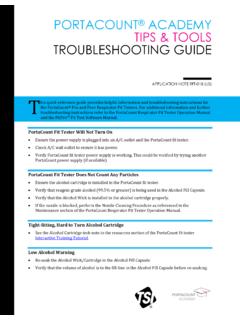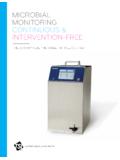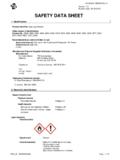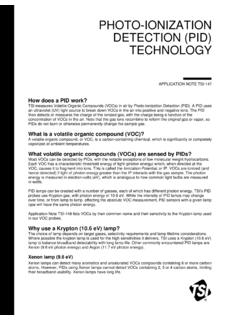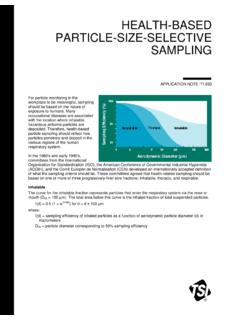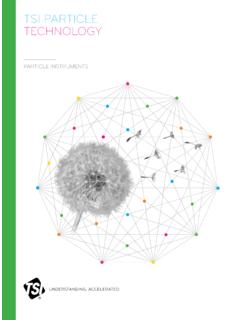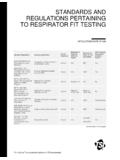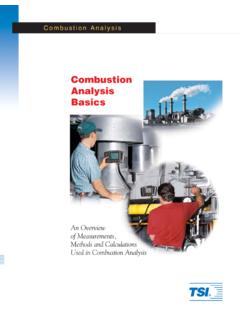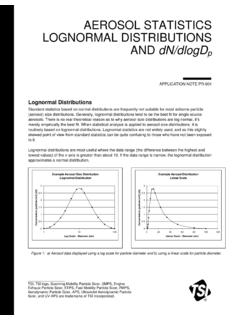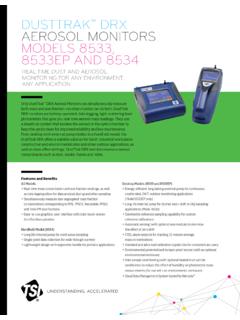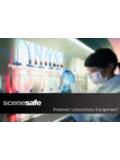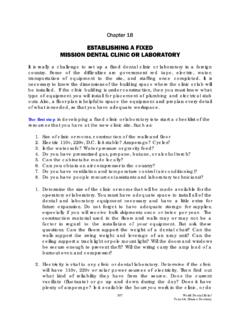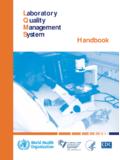Transcription of LABORATORY DESIGN HANDBOOK - TSI, Inc
1 LABORATORY . DESIGN HANDBOOK . UNDERSTANDING, ACCELERATED. LABORATORY . DESIGN . HANDBOOK . _____. TSI, TSI logo, are registered trademarks of TSI Incorporated. Copyright 2014 by TSI Incorporated This HANDBOOK is not intended to be a comprehensive guide to all accepted practices relating to the DESIGN of laboratories, their HVAC systems and controls. No HANDBOOK can instill that level of expertise. Instead, this HANDBOOK focuses on concepts needed to gain a basic understanding of the goals of a LABORATORY and how controls can help meet those goals. ii TSI Incorporated LABORATORY DESIGN HANDBOOK CONTENTS. Contents .. iii Introduction .. 1. General Goals of LABORATORY .
2 2. Comfort ..2. Energy Efficiency ..2. LABORATORY Ventilation .. 3. Determining Supply Air Needed ..3. Lab Control Type .. 5. Constant 2-Position ..6. Warning ..7. Variable Air Volume (VAV) ..8. Diversity ..9. LABORATORY Room 11. Direct Pressure Controls .. 11. Flow Tracking Controls .. 12. Flow Tracking with Pressure Feedback Controls .. 13. Temperature Control .. 14. Fume Hoods .. 15. Architectural Issues .. 15. Fume Hood 16. Test 1 Flow Visualization ..16. Test 2 Face Velocity ..16. Test 3 Containment ..17. Fume Hood Control Type .. 18. Constant Volume Fume Hoods .. 18. 2-Position Fume Hoods .. 19. VAV Fume Hoods .. 20. VAV Hood Controls.
3 22. Sash Position 22. Sidewall Sensing Controls .. 22. Control Components .. 23. Dampers .. 23. Flow Stations .. 24. Venturi Valves .. 25. LABORATORY DESIGN HANDBOOK iii LABORATORY DESIGN HANDBOOK Conclusion .. 26. Appendix A Other Sources of Information .. 27. Appendix B Calculating Airflows with Diversity .. 29. Appendix C Control Sequence .. 31. iv TSI Incorporated LABORATORY DESIGN HANDBOOK INTRODUCTION. The use of chemicals and other potentially hazardous compounds separates laboratories from other types of building spaces. Protecting the health and safety of LABORATORY and building occupants must be the primary concern. Comfort and energy-efficiency are also of considerable importance.
4 The space temperature must remain comfortable for occupants while maintaining an appropriate temperature for chemical processes. At the same time, facilities are under pressure to minimize operating costs. Even including the general criterion of safety, not all laboratories are alike. Different laboratories contain different hazard levels and uses. As an extreme example, it would be inappropriate to DESIGN a high-containment biological LABORATORY as if it were a general chemistry LABORATORY due to the high consequences should a biological LABORATORY 's containment be breached. A host of criteria, including safety, comfort and energy efficiency, must be considered when a LABORATORY is planned or renovated in order to determine the optimal DESIGN .
5 LABORATORY DESIGN HANDBOOK 1. LABORATORY DESIGN HANDBOOK GENERAL GOALS OF LABORATORY . Safety Laboratories are designed to maintain the health and well-being of occupants. Potentially hazardous substances used in different laboratories include chemicals, radioactive materials and infectious biological agents. These materials can be manipulated daily as part of experiments, research or production. Safety must remain the primary goal of a LABORATORY . Regulations, guidelines and standards to ensure LABORATORY safety have been published by many industry groups, many of which can be found in Appendix A. Complying with those requirements is a primary step in achieving LABORATORY safety objectives.
6 Comfort LABORATORY safety has to be balanced with worker comfort. Comfort primarily is concerned with maintaining appropriate temperatures and air velocities. Worker productivity will suffer if the space is too warm or too cool. Similarly, spaces with high air currents are perceived as drafty and cool. Air currents also impact safety by limiting containment in fume hoods and other protective equipment. Ease of use of the LABORATORY equipment is also a factor in worker comfort. Laboratories employing highly specialized equipment, like glove boxes, may be safest. However, this equipment carries an ease of use penalty inappropriate for the hazards encountered in most chemical laboratories.
7 LABORATORY equipment and layout must allow staff to perform necessary tasks with minimal additional effort. Energy Efficiency Laboratories are normally designed as once-through systems, without recirculation 1. Conditioning, supplying and exhausting the large volumes of air used in laboratories consumes sizeable quantities of energy. Reducing these energy costs has a direct impact on a company's bottom line. Laboratories must be designed so that energy efficiency gains do not reduce safety and comfort. 1 National Fire Protection Association, Standard NFPA 45-2000. Section , p. 12. 2 TSI Incorporated LABORATORY DESIGN HANDBOOK LABORATORY VENTILATION.
8 The key concept of LABORATORY ventilation is that air entering the LABORATORY must exit the LABORATORY . The inflowing air volume, normally composed of supply air and infiltration, will exactly equal the outgoing air volume, or air exhausted through room exhaust, fume hoods, canopy hoods, biological safety cabinets and exfiltration. All airflows must be accounted for when designing a building with laboratories. Figure 1. All air exhausted from a lab must enter through either the building HVAC system or In practice, the volume of air supplied intoinfiltration. a LABORATORY is less than the amount of air exhausted, creating negative pressure.
9 The additional air exhausted creates a low-pressure vacuum, pulling air in from adjacent spaces through cracks in the wall, the door undercut, unsealed duct and piping openings or other wall penetrations. Determining Supply Air Needed Three drivers determine the required volume of supply air in a LABORATORY : temperature, exhaust, and ventilation. Temperature-driven laboratories hold a lot of equipment to perform chemical analysis or ovens and heating elements to speed up chemical processes. Without an adequate supply of cool air, the LABORATORY housing this equipment will become uncomfortably warm. Lights, LABORATORY personnel, and even heat transmitted through the building also contribute to the cooling load of a LABORATORY .
10 Determining the necessary supply air volume for cooling involves summing up all of these loads. However, loads other than the building envelope should be determined according to expected usage. For example, engineers Figure 2. Supply air volume in laboratories with high heat revise supply air volume downward loads, such as computers, ovens and other electrical if all of a LABORATORY 's equipment equipment, is driven by cooling requirements. will not be used simultaneously. LABORATORY DESIGN HANDBOOK 3. LABORATORY DESIGN HANDBOOK Figure 3. High volumes of air exhausted from fume hoods, canopy hoods and other exhausts require a correspondingly large volume of air to be supplied to a LABORATORY .
